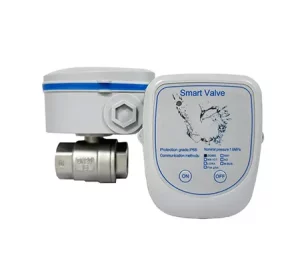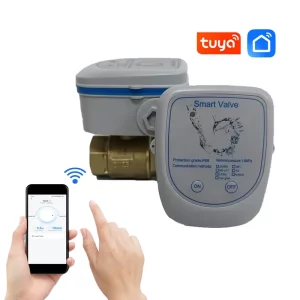Avoid your inquiry is delay response, please enter your WhatsApp/WeChat/Skype along with the message, so we can contact you at the very first time
We will reply you within 24 hours. If for urgent case, please add WhatsApp: +8613188899036, or WeChat: 0531-87968777. Or call 0531-87968777 directly.
* We respect your confidentiality and all information are protected. We will only use your information to respond to your inquiry and will never send unsolicited emails or promotional messages.
Outdated valve systems often lead to water leaks, wasted energy, and unpredictable maintenance costs. These hidden problems disrupt building operations and strain industrial facilities, causing stress for engineers and property managers. Smart valve technology solves these challenges by delivering precise control, real-time monitoring, and seamless integration—ensuring systems run efficiently and securely.
What is a smart valve?
A smart valve is an intelligent control device equipped with sensors, actuators, and connectivity that monitors and regulates fluid flow in real-time. Designed for remote operation and precision management, smart valves optimize water and energy use, prevent leaks, and provide actionable data for building automation and industrial systems.

smart valve™ automatic monitoring system
At its core, a smart valve combines the mechanical strength of traditional valves with the intelligence of digital sensors and automated actuators. Unlike conventional valves that require manual adjustment, a smart valve can monitor water flow, pressure (psi), and temperature in real-time.
Example in Practice:
A smart valve in a commercial HVAC system continually adapts to demand, optimizing fluid delivery for comfort and efficiency.
“Today’s smart valve™ solutions equip buildings with real-time data, supporting proactive maintenance and sustainable operations.”
Explore the smart valve product line for more details.
Problem:
Manual valve systems are slow, prone to human error, and unable to deliver precise control or instant feedback. This causes inefficiency, unnecessary water consumption, and potential equipment failure due to undetected leaks.
Smart Valve Solution:
Smart water valves, ball valves, and other automated fluid control systems offer:
“Industrial plants using smart water valves have reduced water loss by over 30% through rapid leak detection and automated shut-off.”
Related Reading:
Learn about smart valve water technology for modern building systems.
Smart valves are equipped with advanced detection algorithms and sensors that continuously monitor water flow, system pressure, and temperature. By comparing real-time data with expected values, the valve identifies anomalies—such as a sudden drop in pressure or an unexpected increase in flow rate.
| Feature | Traditional Valve | Smart Valve |
|---|---|---|
| Leak Detection | Manual | Automatic, real-time |
| Data Logging | No | Yes |
| Remote Operation | No | Yes |
| Predictive Maintenance | No | Yes |
Case Study:
A municipal water system in Europe adopted smart valves and achieved annual savings of $200,000 in reduced water loss and maintenance costs.
Smart valve technology comes in many varieties, each suited for different fluid dynamics, flow control, and installation requirements.
Application Scenarios:
Integrating a smart valve requires thoughtful planning and attention to system compatibility, but most modern valves are designed for simple, plug-and-play installation.
Example:
A data center integrates smart water valves with its BMS to enable precise cooling and automatic anomaly detection, ensuring equipment stays protected at all times.
Explore our intelligent valve and smart valve water integration options for automation.
The advantages of adopting smart valve technology go far beyond simple convenience.
“A factory that switched to smart ball valves reported a 25% reduction in unscheduled maintenance events in the first year.”
IoT (Internet of Things) is a game-changer for valve technology. By enabling real-time, wireless data transfer, IoT-connected smart valves allow engineers and facility managers to monitor and control fluid systems from anywhere.
Application Example:
A city water utility deploys thousands of IoT-enabled smart valves, allowing real-time adjustments during peak demand, thus ensuring stable pressure and preventing service interruptions.
Learn more about electric actuator connectivity for industrial applications.

Municipalities are under pressure to modernize water and sewer systems, making smart water valves critical assets for:
Case Example:
A municipal water district installed smart valve solutions across their network, cutting annual water losses by 15% and enhancing response time for main breaks.
Further Reading:
Explore how smart water valve technology is transforming infrastructure.
Selecting the ideal smart valve requires evaluating several technical and practical considerations.
Checklist for Buyers:
Browse our complete smart valve and flow regulating valve range.
What distinguishes a smart valve from a standard valve?
Smart valves feature embedded sensors, automated actuators, and connectivity for real-time monitoring and remote operation—enabling leak detection and optimization not possible with traditional valves.
Can a smart valve be installed in existing pipe networks?
Yes, most modern smart valves are adaptable and support retrofitting, as long as diameter and pressure ratings match.
How do smart valves help with predictive maintenance?
Continuous monitoring allows the valve to spot wear or faults early, sending alerts for maintenance before breakdowns occur.
Is smart valve technology energy-efficient?
Absolutely. Automation and precision control cut unnecessary water flow, optimize system pressure, and support sustainability goals.
What industries benefit from smart ball valves and smart water valves?
Industries ranging from commercial buildings, manufacturing, water and sewer, to agriculture and public infrastructure benefit from improved reliability and efficiency.
Do smart valves require a specific interface to operate?
Most support standard automation interfaces and protocols, making integration straightforward for building automation engineers and system integrators.
Take the next step toward smarter, more efficient fluid control. Contact our technical experts for a custom smart valve solution designed for your project.